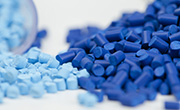Plastics Business
Raw material procurement and precision molding services
List of resin raw materials handled
Engineering plastics
PA (Polyamide [also known as Nylon])
Advantages: Excellent in impact resistance, chemical resistance, friction and abrasion resistance, and holds gas barrier properties. Excellent impact resistance, chemical resistance, friction and abrasion resistance, and gas barrier properties.
Disadvantages: High water absorption and lack of dimensional stability.
PC (Polycarbonate)
Advantages: Excellent in transparency, dimensional stability, and impact resistance, with a wide usable temperature range of -40 to +120°C
Disadvantages: Poor chemical resistance.
POM (Polyacetal)
Advantages: Well-balanced mechanical properties, especially fatigue resistance, chemical resistance, friction and wear resistance.
Disadvantages: No transparency (milky white, generally treated with color)
m-PPE (modified polyphenylene ether)
Advantages: Excellent hydrolysis resistance and electrical properties, low specific gravity and the lowest water absorption rate among general-purpose engineering plastics.
Disadvantages: Weak against organic solvents
PBT (Polybutylene terephthalate)
Advantages: PBT (polybutylene terephthalate) has excellent sliding properties (friction and abrasion), impact resistance, and electrical insulation properties. Excellent in sliding properties (friction and wear), impact resistance, and electrical insulation ・Excellent in compatibility with other resins and fillers, so it is used as a composite grade material
Disadvantages: Hydrolysis, heat resistance (non-reinforced)
PTFE and others (fluoropolymers)
There are copolymers such as FEP, ETFE, PVDF, PCTFE, ECTFE, PVF, etc. to add melt formability to PTFE (ethylene tetrafluoride)
Advantages: Heat and cold resistance, chemical resistance, electrical insulation, low moisture and water absorption.
Disadvantages: Poor moldability.
GF-PET (Glass fiber reinforced polyethylene terephthalate)
Glass fiber reinforced polyethylene phthalate (GF-PET) is produced by compounding PET resin with glass fiber and other materials. Mechanical properties and heat resistance are improved by reinforcing with glass fiber.
Advantages: Excellent in toughness, heat resistance, organic solvent resistance, oil resistance, and electrical properties.
Disadvantages: Poor in heat and alkali resistance.
Super engineering plastics
PPS (Polyphenylene sulfide)
Advantages: Excellent in mechanical strength, rigidity, flame resistance, chemical resistance, electrical properties, dimensional stability, etc.
Disadvantages: Expensive. Impact resistance (notch effect) and abrasion resistance are inferior.
PSU (Polysulfone)
Advantages: Has oxidation resistance and thermal stability, can be used at high temperatures for a long period of time, amber transparency, excellent steam resistance and hydrolysis resistance.
Disadvantages: Expensive, susceptible to organic solvents.
PES (Polyethersulfone)
Advantages: Excellent heat and steam resistance due to the absence of hydrolyzable bonds, yellowish brown transparency, better heat resistance than PSU.
Disadvantages: Expensive. Vulnerable to some organic solvents.
PAR (Polyarylate)
Advantages: Almost completely blocks ultraviolet rays with a wavelength of 350 nm or less, and exhibits transparency equivalent to polycarbonate.
Disadvantages: Expensive.
PAI (Polyamide-imide)
Advantages: Dimensional stability, self-lubricating (especially at high temperatures), chemical resistance (acid systems)
Disadvantages: Expensive. Poor alkali resistance.
TPI (Thermoplastic Polyimide)
Enables injection/extrusion processing without compromising the properties of polyimide resin, thereby expanding its application range. High glass transition temperature, high melting point.
Advantages: Excellent in dimensional stability, friction resistance, sliding properties (under high temperature), radiation resistance, low water absorption, chemical resistance, flame retardance, and radiation resistance.
Disadvantages: Inferior dielectric properties.
PEI (Polyetherimide)
Advantages: Can be melt-molded in various ways, and is resistant to high-pressure steam and gamma radiation. Transparent, amber in color, excellent in steam resistance and solvent resistance.
Disadvantages: Expensive. Impact resistance (notch effect) is inferior.
PEEK (Polyetheretherketone)
Advantages: Excellent in heat degradation resistance, mechanical properties, heat and water resistance, radiation resistance, chemical resistance, and flame retardance, and can be processed by injection and extrusion molding.
Disadvantages: Expensive.
LCP (liquid crystal polymer)
LCP (liquid crystal polymer) is a general term for thermoplastic resins that exhibit liquid crystalline properties when melted, and is classified into fully aromatic resins that excel in heat resistance and semi-aromatic resins that excel in thin flowability.
Advantages: Excellent in heat resistance, fluidity, dimensional stability, damping properties, and chemical resistance.
Request for Quotation
Please feel free to request a quotation, even for small quantities.
We will make arrangements for smooth and reliable molding.
If you have any questions, please feel free to contact us.







